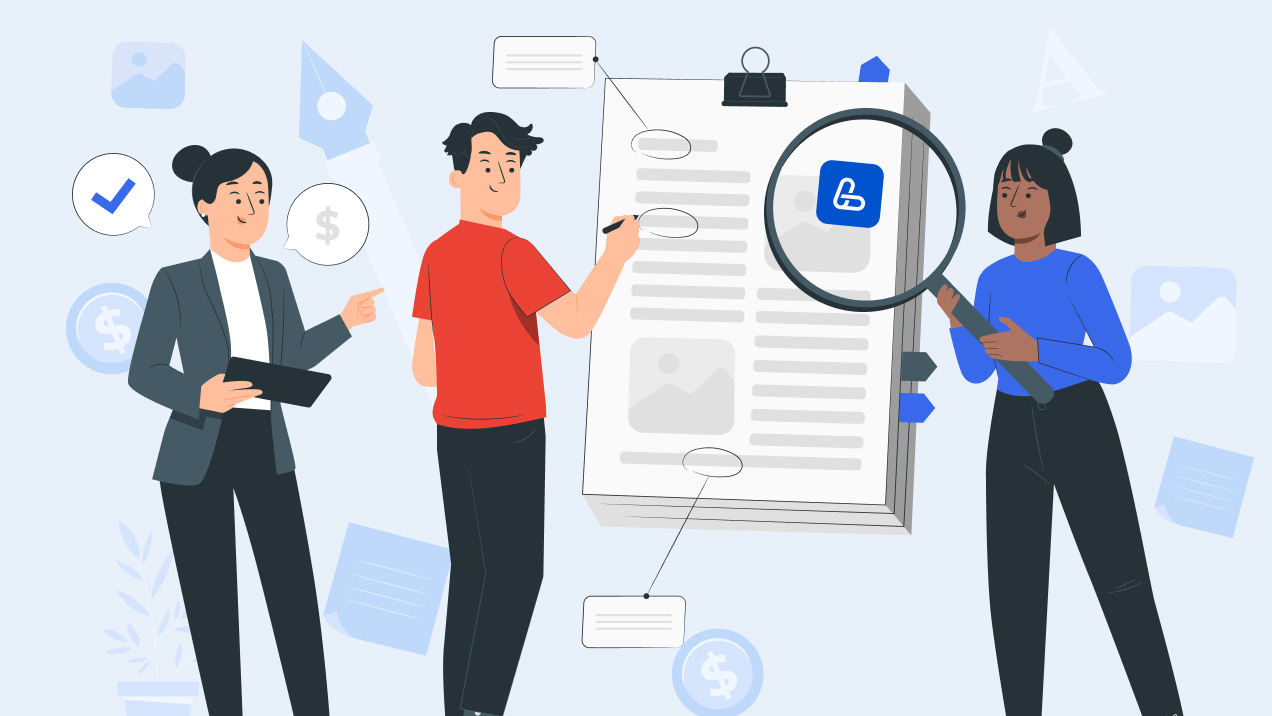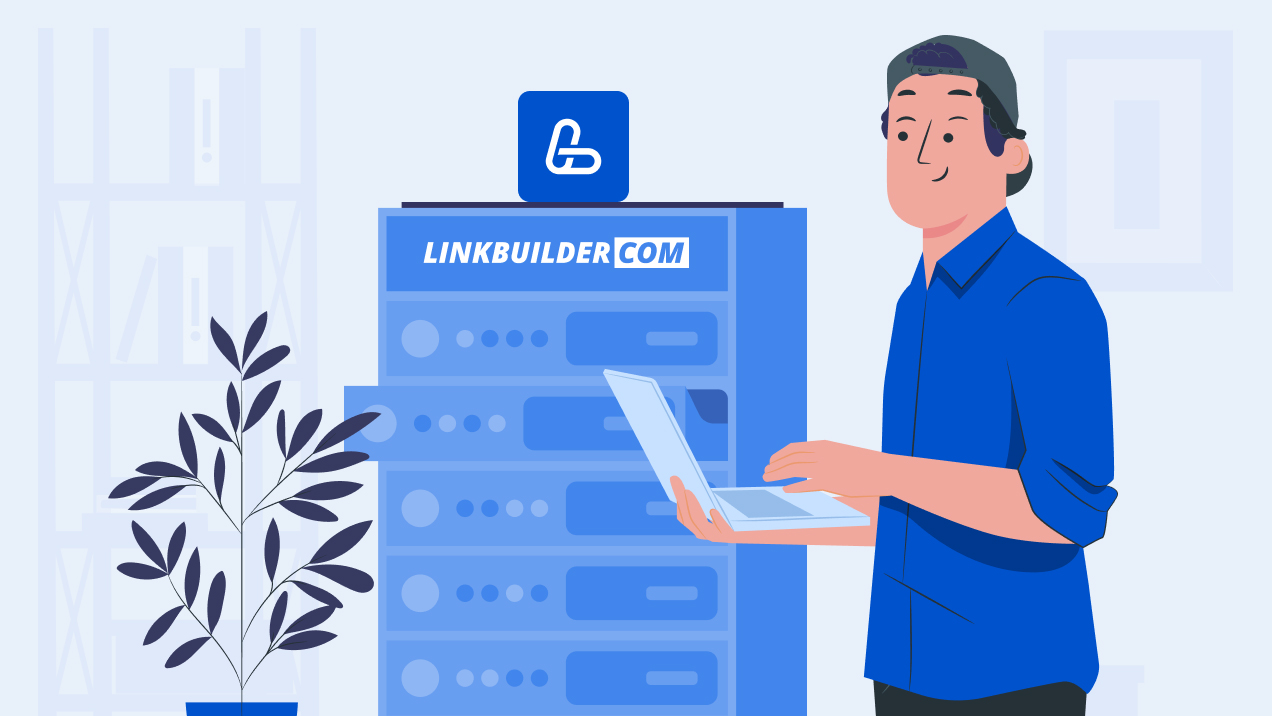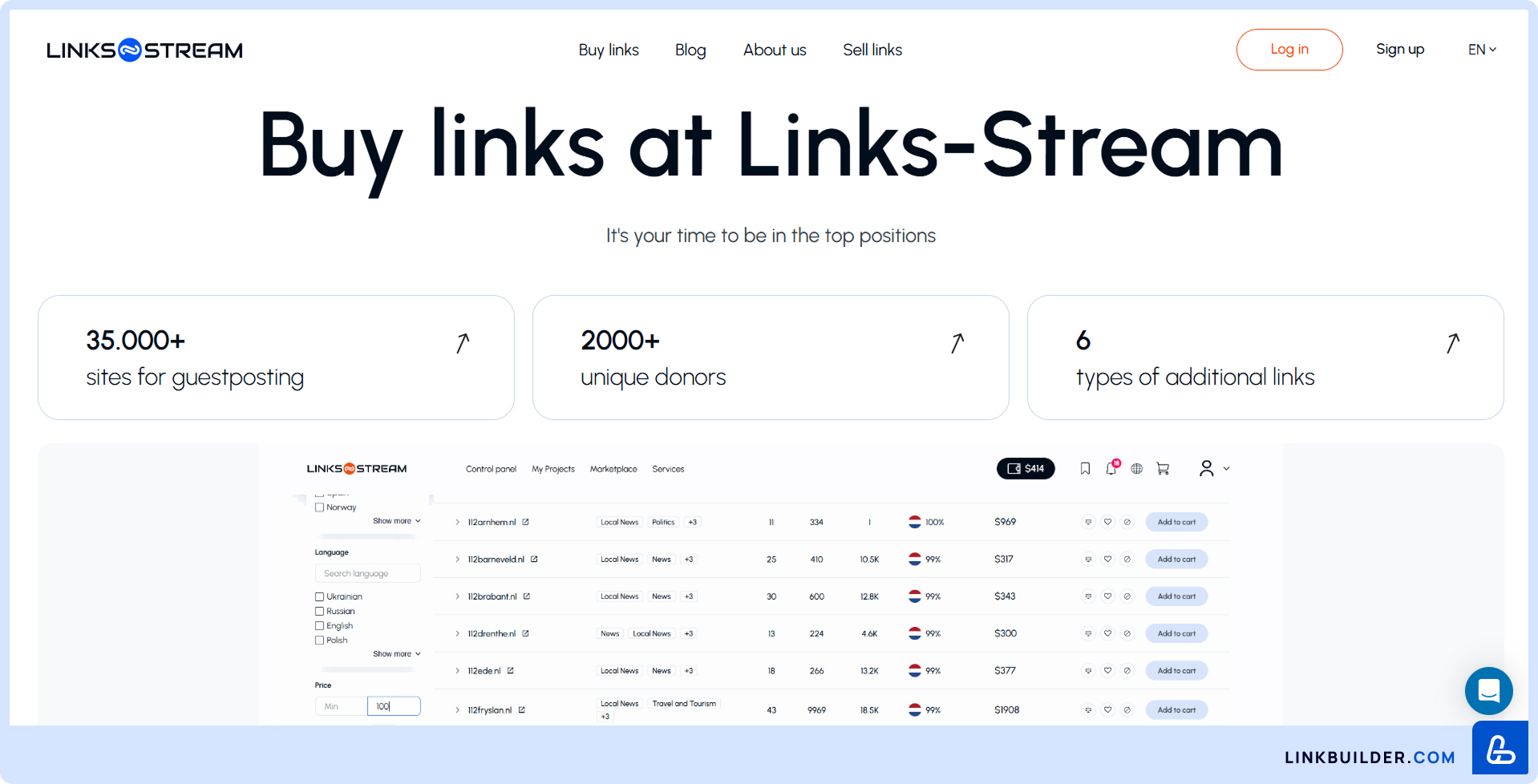Linkbuilding remains a vital tool for strengthening online presence, but its cost and effectiveness change yearly. In 2026, approaches to building a backlink profile have become more demanding, and search engines are even more stringent in evaluating the quality of backlinks.
In 2026, website owners and SEO specialists are most concerned about the following: What are the link building prices in 2026? What factors affect them? Have the promotion trends changed compared to previous years? How can businesses promote themselves more effectively, and what is required to achieve this?
Today, the cost of link building depends not only on the number of links but also on their quality, the authority of the linking websites, the method of obtaining backlinks, and the geotargeting. Moreover, outreach, brand mentions, PR campaigns, and collaboration with bloggers are becoming increasingly crucial for effective strategy.
In this article, we will examine how to calculate the cost of a link-building campaign, discuss current prices, highlight key trends in the SEO market, and, most importantly, provide guidance on choosing the optimal strategy for achieving the best results for your business development.
Evolution of Link Building: From Quantity to Quality
Over the past few decades, link building has seen tremendous transformation. While the main criteria for effectiveness used to be the number of links, their quality plays a key role today.
In the 2000s, SEO specialists widely used automated methods for building a backlink profile, site directories, spammy comments, and link farms. However, Google continuously improved its algorithms. The Penguin update (2012) drastically changed the approach to link building, and websites began to fall in rankings.
Modern, effective SEO link building is based on relevance, naturalness, and the authoritativeness of the linking websites. The most widely employed methods are guest blogging, PR campaigns, and content marketing. High-quality links help achieve stable SEO results and avoid potential pitfalls and wasted investments.
The link quality evaluation system in 2026 includes:
- High content relevance
- Authority of the source domain
- Natural obtaining of links
- Uniqueness and usefulness of information
- Social activity around the content
- Author's expertise
The importance of link building is hard to overestimate, although its role and impact evolve with the progression of search algorithms. In 2026, the link-building strategy is also a crucial part of overall digital marketing, where not only acquiring backlinks but also their quality, relevance, and natural acquisition matter.
Today, successful promotion depends on balancing various SEO factors. External links define a site's authority and increase its rankings, but if the site lacks quality content and technical optimization, the effectiveness of link building decreases.
The continuous development of Google's algorithms, an increased focus on content quality, and new opportunities for obtaining links make the link-building process more complex. Let's explore the key trends shaping link building in 2026 and how SEO specialists can adapt their strategies to the new realities.
Key Link-Building Trends in 2026
By 2026, it has become a strategy to help you acquire high-quality, contextually relevant backlinks. Here are the top link building trends shaping SEO effectiveness:
- Quality Over Quantity: Search engines now prioritize the quality of backlinks over sheer volume. A few authoritative and relevant links are far more valuable than dozens of low-quality ones.
- Natural Backlink Profiles: Backlinks should appear organic rather than artificially created. Search algorithms increasingly focus on detecting and rewarding natural link growth.
- Relevance and Topical Alignment: Links from websites with topics relevant to your industry or niche carry more SEO value and contribute to a stronger backlink profile.
- Mixed Content Formats: Using diverse content types, such as articles, blogs, videos, and infographics, enhances engagement and supports a more varied and effective link-building strategy.
- Collaboration with Influencers and Key Opinion Leaders: Partnering with trusted influencers and authoritative bloggers can attract high-quality backlinks while boosting brand credibility and visibility.
- Competitor Analysis: Analyzing competitors’ link building strategies is a core part of crafting a winning SEO approach.
- Local Link Building for Geo-Targeted SEO: Securing backlinks from local sources is increasingly important for businesses targeting specific regions or countries.
- Cross-Channel Integration: Link building delivers the best results when aligned with other digital marketing efforts, such as content marketing, public relations, and social media.
- Digital PR as the Foundation of Link Building: In 2026, Digital PR emerges as one of the primary sources for high-quality backlinks. Search engines increasingly value links from editorial content, industry media, and expert publications, as these mentions occur naturally and reflect genuine brand authority.
- Rising Importance of Brand and Brand Signals: Algorithms are placing greater emphasis on brand recognition when evaluating link profiles. Branded anchors, company mentions, and navigational queries boost site trust, while brand-tied links are seen as safer and more sustainable long-term.
- Unlinked Brand Mentions: In 2026, brand mentions without active links become integral to overall link building and reputation SEO strategies. Search engines can factor in these signals, and such mentions often serve as a foundation for outreach efforts to secure quality backlinks.
- Link Profile Safety: Search engines continue to reduce tolerance for manipulative link building tactics. Instead of harsh penalties, low-quality links are increasingly ignored or devalued, making steady growth, source diversity, and avoidance of unnatural patterns crucial.
- Focus on Referring Domains: The key factor shifts from link quantity to the number and quality of unique referring domains. Links from new, relevant, and trustworthy sites have a greater impact than repeated placements on the same resources.
- Content as the Core Reason for Links: In 2026, content increasingly acts not just as a wrapper for links but as the primary driver for earning them. Research, original data, expert insights, and valuable resources encourage natural mentions and enhance link profile value amid the rise of AI-generated content.
What Has Changed in the Main Factors of Link Building?
The Introduction of Artificial Intelligence
Artificial intelligence radically changed the link-building and SEO approach. Today, AI tools automate routine processes and help identify the most promising platforms for placing links by analyzing vast data sets in minutes.
AI has also significantly impacted pricing. Websites using advanced data analysis technologies to assess the value of their links now set higher prices, as they can more accurately prove their effectiveness.
Also, it's worth noting that search engines are now better at detecting unnatural link-building schemes through their own AI algorithms. This has led to an increase in the cost of high-quality, organic links, as creating them has become more challenging, and their value has risen.
Changes in Link Effectiveness Metrics (CTR, Traffic vs. Rankings)
In 2026, there is a trend toward changing how experts assess the link effectiveness. While previously, the primary success metric was its impact on search rankings, now CTR (click-through rate) and referral traffic volume have become just as important.
Search engines are increasingly considering behavioral factors when assessing the value of links. Links that generate real traffic and engagement are rated significantly higher than those that merely exist on a page without user interaction.
Digital marketers are now willing to pay more for links that improve rankings and directly attract the target audience. It has led to a rise in the cost of links on websites with high user engagement, even if their traditional SEO metrics (DA, DR) are not particularly high.
This trend has also influenced link placement strategies. Now, more attention is given to context, anchor text, and link positioning on a page – all of which aim to maximize clickability.
Brand Signals and Their Impact on Link Pricing
Brand signals have become one of the most critical factors in SEO link building. Search engines have developed complex algorithms to determine a site's "brand value" and its content, which directly impacts the weight of links.
Links from solid brands convey more authority and are also perceived by users as more reliable recommendations. This has created a new link building pricing model, where mentions from well-known brands can cost 3-5 times more than those from niche resources with similar SEO metrics.
Interestingly, even indirect associations with a brand (e.g., links from a site that is frequently mentioned alongside authoritative brands) influence link pricing.
Growing Role of Expertise
Links from recognized industry experts, academic institutions, and authoritative industry resources are increasing in value. To assess how much does link building cost, it's essential to understand that a link from an author with verified expertise can be more expensive than a link from a site with high DR but no clear expert position.
Websites that have involved specialists in their development (e.g., by obtaining certifications, publishing original research, etc.) can now set higher prices for placing links or mentions.
This trend has also influenced link-building agencies. They now more often collaborate with industry experts, researchers, and authoritative writers, which increases the overall cost of services but ensures higher quality and effectiveness of links.
The Impact of Multi-format Content on Link Pricing
Multi-format content has become one of the most potent link-building trends in 2026. Search engines are increasingly indexing and evaluating content in various formats: videos, podcasts, interactive infographics, and AR/VR presentations.
Links integrated into such content have gained exceptional value. For example, a brand mention in a popular podcast with a script and a link included can cost 2-3 times more than a traditional link in text content.
Links from video content have become especially valuable. As video dominates content consumption, links in video descriptions or subtitles significantly impact SEO metrics.
This trend has also led to a review of many platforms' pricing policies. Now, they often offer comprehensive packages that include mentions in different content formats, increasing the average cost of placement but ensuring higher effectiveness.
Search Personalization and Its Impact on Link-Building Strategies
Search result personalization has reached a new level, significantly affecting link-building strategies. Search engines now consider the user's query and interests, search history, geographic location, and even social connections.
Link targeting technologies have also impacted pricing. Some platforms now offer "smart placements," where links are shown only to relevant visitors, which increases the cost of such placements but significantly improves their effectiveness.
Geo-targeted links have become a separate category with their pricing policies. Links aimed at users from specific regions or cities can be more costly, especially for local businesses.
Despite all the updates, obtaining quality links becomes more complex each year. Changes in search algorithms, rising backlink costs, issues with donor quality, and niche competition present serious challenges for SEO specialists.
Link Building Challenges Affecting Pricing
The Continuous Complication of Search Engine Algorithms
Google constantly refines its algorithms to reduce the impact of artificial link building on website rankings. Therefore, there is a need to focus on natural backlinks obtained through quality content, PR campaigns, and partnerships.
Increased Competition Across All Niches
Each year, more companies realize the importance of SEO and link building, and competition becomes fierce. In highly competitive niches like finance, healthcare, gambling, and technology, obtaining quality links has become more expensive and complicated.
The Need for Continuous Learning and Adaptation
SEO and link building are rapidly changing fields. Strategies that worked just a few years ago may no longer be effective today. Professionals must regularly update their knowledge, study new methods, and test different approaches.
Requirements for Content Uniqueness
Today, creating a text with keywords and obtaining links is no longer enough. Google emphasizes content uniqueness and usefulness, which complicates the link placement process.
Backlinks remain the core of link building and SEO promotion. However, modern Google algorithms are becoming more adept at detecting manipulative links and appreciate more natural backlinks.
How Has Google's Stance Toward Backlinks Changed?
Zero Value of Spammy Links
Google uses advanced algorithms to detect spammy links, forcing SEO specialists to focus on organic and high-quality link building (e.g., Google Penguin and its updates).
Source Authority
It's not just about the presence of links but also the reputation of the linking site. Algorithms assess the relationships between websites and their relevance. Therefore, obtaining links from obscure or irrelevant resources will no longer have a positive effect.
AI's Role in Determining Content Quality
Google's machine learning is becoming better at recognizing natural links, which forces link builders to create genuinely valuable content. For example, articles that generate many organic links receive additional search bonuses.
The Impact of the Google Helpful Content Update
The update aimed at flagging low-quality content has pushed SEO specialists to focus on expert and in-depth content that truly solves user problems.
Google consistently transforms its policy toward external links. While the focus was previously mainly on obvious manipulations, search engines now use more sophisticated algorithms to analyze link acquisition. Therefore, the best approach for ensuring long-term results and improving trust in a site and its position in search engines is to use white-hat link building.
White-hat Link Building as the Industry Standard
White-hat link building has become the primary approach for building a backlink profile. It involves obtaining natural links through quality content, PR campaigns, and collaborations. White-hat link building pricing is usually higher due to the near absence of risks from search engine penalties.
Its methods include:
- Guest Posts on Authoritative Resources
Companies are investing more in creating quality content published on trusted sites. Avoiding mass placement and focusing on high-trust, relevant sites is essential. - PR Campaigns and Digital Marketing
Naturally obtaining links through news hooks, expert opinions, and press releases. Brands actively use journalistic platforms to get links from well-known media outlets. - Influencer Collaborations
Bloggers and thought leaders are key partners in link building strategies. The native mention format in videos, social networks, or blogs offers an opportunity to obtain authoritative backlinks. - Forum Posting
Involves participating in themed discussions on forums, Q&A platforms, and social networks with valuable responses containing links to relevant content.
With the development of digital platforms, new opportunities for building links have emerged.
New Platforms and Formats for Obtaining Links
Social Media and Content Platforms
TikTok, LinkedIn, Medium, and Reddit are becoming platforms to place helpful content with links. Mentions in thematic LinkedIn communities and organic posts on Medium are especially valuable.
Forum Marketing and Communities
Placing expert answers in thematic communities (Quora, Stack Overflow, Reddit) increases trust in the brand and generates natural links.
Podcasts and Video Content
Including links in podcast descriptions, YouTube videos, and webinars is becoming an effective way to build a backlink profile. For example, inviting experts to podcasts can help gain natural backlinks.
AI-Generated Content
Use neural networks to create quality content that attracts the audience's attention and generates natural links.
Link Building and Content Marketing Integration
Link building is becoming an integral part of content marketing strategies. The main approaches include:
- Creating Link Magnets
Infographics, research, guides, and helpful articles encourage other sites to link to the source. For example, an article with unique statistical data can gain dozens of natural backlinks. - Collaborations with Media
Journalists are more likely to link to sites that offer unique data and interesting news, so it’s important to create content with informational value. - Content Transformation
Turning a blog into a podcast, video, or infographic provides more opportunities for obtaining backlinks. Different formats allow for reaching a wider audience. - Using Unique Content
Publishing your research and surveys increases the likelihood of obtaining natural links.
Factors Influencing Link Building Pricing

The pricing of SEO link building depends on several factors that determine the cost of each link. SEO specialists, business owners, and digital marketers must consider these aspects to optimize the costs of building a healthy backlink profile and get the maximum return on investment.
All prices mentioned in this article were determined by analyzing link-building costs on various link marketplaces and using multiple analysis tools.
Level of Competition in the Niche
A key factor determining the cost of link building in 2026 is the level of competition in a particular niche. The higher the competition, the more costly it will be to acquire high-quality links.
- Highly competitive niches (e.g., finance, insurance, gambling, healthcare) face fierce competition for top positions in Google’s search results. High-quality links from authoritative resources can cost between $300 and $2000 per link in these industries.
- Medium-competitive niches (e.g., education, IT, e-commerce) offer more affordable link-building options, ranging from $100 to $500.
- Low-competitive niches (e.g., regional businesses, niche-specific services) allow for acquiring links at much lower prices, from $50 to $200.
SEO Metrics of Donor Sites
One of the most critical indicators of link value is the site's authority from which you obtain the link. The following metrics are typically used to evaluate the source's authority:
- Domain Rating (DR) by Ahrefs
- Domain Authority (DA) by Moz
- Trust Flow (TF) by Majestic
The higher the DR/DA score, the more expensive the link:
- DA/DR 70+ – top authoritative sites requiring significant financial investment (from $1000 per link).
- DA/DR 50-70 – medium-authority platforms, with link prices ranging from $300 to $800.
- DA/DR 30-50 – quality mid-level sites, with links costing between $100 and $400.
- DA/DR <30 – less influential sites offering links for $50–$150.
There is a clear correlation between DR/DA values and the cost of backlinks in 2026. Sites with DR 50+ can set prices 3-5 times higher than those with DR 30-40, even if other metrics are similar. For the premium segment (DR 70+), a 5-10 point rating difference can lead to a 25-40% increase in cost.
Majestic's Citation Flow (CF) and Trust Flow (TF) still play a crucial role in assessing the quality of a link profile. Sites with a high TF/CF ratio are especially valuable, as they indicate a high-quality link profile. The difference in pricing between sites with the same DA/DR but different TF/CF can be up to 20-30%.
Website owners now rarely set prices based solely on a single metric. Instead, they conduct a comprehensive analysis of various metrics. This approach has resulted in a fairer pricing policy, preventing the artificial inflation of costs based solely on a high score in any metric.
What Drives the Total Costs of Link Building?
Link building costs also depend on the scale of the campaign. The key criteria influencing the overall cost include:
- Number of required links. The more backlinks needed, the more funds will need to be invested. Bulk purchases often have a reduced average cost per link.
- Placement frequency. If you need to build the backlink profile quickly, the cost may be higher, as more expensive platforms or additional resources may be employed.
- Link quality. Cheaper links from less authoritative sites may be less effective, so balancing quantity and quality is crucial.
Industry Specificity and Topic Complexity
Some topics are more challenging for link building due to content restrictions, strict editorial policies of donor sites, or narrow niche targeting. These factors also affect link building services pricing.
- Finance, healthcare, and law
Links in these areas require special attention to content quality and the reputation of donor sites. Due to high manipulation risks and regulatory requirements, the price for backlinks in these niches is higher. - Gambling, crypto, betting
Niche sites with high earnings are willing to pay large sums of money for link placements, as many authoritative platforms refuse to work with such topics. - Niche B2B industries
Obtaining links can be difficult since most authoritative resources are unwilling to place commercial content for free. In such cases, organic PR and content marketing methods are needed.
Impact of Topic and Relevance on Price
Search algorithms have significantly improved their ability to assess the relevance of links, which has radically changed how they evaluate links.
- Price Increase for Backlinks: Links from thematically relevant sites can cost 40-70% more than links from irrelevant platforms with similar metrics. It's particularly true for specialized niches that require significant expertise in specific themes. For example, a link from a medical resource to a health-related website may cost twice as much as a link from a general site with the same DR.
- New Tools for Evaluating Thematic Relevance: These tools use semantic analysis and natural language processing to determine the degree of relevance between the donor site and the recipient site. These indicators are now often included as separate criteria in the calculation of link prices.
- Differentiated Approach to Relevance Assessment at the Page Level: Placing a link on a page with high thematic relevance can cost 30-50% more than on a page of the same site with lower relevance.
It's also worth noting the emergence of relevance tiers in pricing. Platforms now often offer different rates depending on how closely the client's topic aligns with the site's primary specialization. It allows for more flexible pricing and maximizes profit.
Geographic Impact
Search localization and the growing importance of regional signals have led to developing a complex system of geographically dependent pricing.
- Regional Dependence: Links from sites with strong positions in specific regions are now priced much higher for businesses targeting those territories. The price difference can reach 50-80%, depending on the competitiveness of the local market. For example, a link from a resource popular in metropolitan areas may cost twice as much for a local business from that region as for a company from another part of the country.
- Geographical Exclusivity: Some platforms offer premium placements, guaranteeing that no links to competitors from the same region will appear in the same material. This option can increase placement costs by 30-50%.
- Local Link Building: Specialized platforms focusing on specific geographical regions offer more precise targeting but at a higher price.
Price Dependence on Link Type
- Dofollow and Nofollow Links. Dofollow links remain the most expensive as they pass the maximum link weight to search engines, but the price difference between various link types has significantly transformed.
- The average price difference between dofollow and nofollow links has decreased to 30-50% (compared to the previous 60-80%). The reason is that search engines now put more value on nofollow links, especially when they are naturally integrated into content and generate real traffic.
- Some high-quality platforms even set the same price for both link types, stating that their value for the brand and traffic does not depend on the attribute.
- UGC Links. UGC (User-Generated Content) backlinks are links that come from content created by users, such as forum posts, blog comments, or social media posts. These traditionally cost 40-60% less than dofollow, but their value has increased for strategies focused on building a natural link profile. UGC links from highly authoritative forums and specialized communities, where they are perceived as natural recommendations, are especially valuable.
- Sponsored Links. Clearly marked as paid advertisements, these are usually the cheapest, costing 50-70% less than dofollow links. However, their role in comprehensive strategies has increased as search engines now positively evaluate the variety of link types in a site's profile. This has led to the creation of so-called balanced packages that include various types of links at a combined price.
- Hybrid Placements. These are instances where different link types are combined within a material. For example, one dofollow link to the main site and several nofollow or sponsored links to internal pages or social media. This structure allows for the optimization of the budget and the maximizing of the benefits of the placement.
Impact of Link Position on the Page
In 2026, link position on a page has become a critical factor in pricing, with significant price differentiation based on placement. This trend is related to a deeper understanding of user behavioral signals and their impact on link effectiveness.
- Links in the Upper Part of the Page (First Screen) – These can now cost 30-50% more than similar links placed lower down, as they receive much more visibility and clicks. Links in the first two paragraphs of the main content are especially valuable. Their price may be twice as high as the links at the end of the article.
- Links in Key Parts of the Content – These backlinks, organically embedded in the most informative parts of the content (e.g., explanations of key concepts or instructions), are valued 40-60% higher than standard placements.
- Interestingly, links in lists (especially in the first three positions) have also become more expensive due to their high readability. Placement in such structured elements may cost 20-30% more than in regular text.
- Link Placement Depending on HTML Element – Links in H2/H3 headings can cost twice as much as those in regular text, as they attract more attention and have higher SEO weight. Similarly, links in image captions and data tables often have increased pricing.
- Premium Placement – Some platforms now offer premium placement with guaranteed visibility. The link is integrated into the most noticeable elements of the page, ensuring a high CTR. Such placements can cost 2-3 times more than standard ones.
Text Size and Its Impact
The volume and quality of the context surrounding a link have become some of the most significant factors in link-building pricing in 2026. Search engines' ability to assess contextual relevance and natural link integration has greatly increased, directly affecting the cost of backlinks.
- Integration into Long-Form Content. These are 40-60% more expensive than placements in short texts. Large materials typically receive more traffic, stay relevant longer, and are perceived as more authoritative by search engines.
- Context Quality. The context surrounding the link is crucial. Links surrounded by relevant, informative text with natural integration may cost 1.5-2 times more than links with formal or artificial context.
- Semantic Proximity of Context to the Target Page. Links placed in contexts with high semantic relevance (as determined by specialized algorithms) can cost 30-50% more due to their higher SEO effectiveness.
- Links in Expert-Written Content. Such placements can cost 2-3 times more than in standard informational articles, as they convey a link value and expert authority.
- Price Differentiation Depending on Content Formats. For example, links in content containing visual elements like infographics, diagrams, and data tables often have higher pricing, as such elements attract more attention and increase time spent on the page.
Key Factors Shaping Link Building Costs

The primary factor shaping the link-building strategy is the quality of backlinks. These determine your site's ranking, authority, and reliability in the eyes of Google and other search engines. However, how is the cost of these services formed, and why can prices vary so significantly? And is link building worth it at all?
How is Link Building Pricing Formed?
1. Quality of Donor Sites
The most crucial factor influencing the cost of link placement is the quality of the donor sites where you place your links. Key indicators of quality include:
- Domain Authority (DA): The higher the DA of the site, the more weight its link passes, and consequently, the higher the price.
- Traffic: Sites with high organic traffic are usually more expensive.
- Topic Relevance: Links from thematically relevant resources are valued more than links from irrelevant ones.
- Domain Age: Older domains with a good history are considered more reliable.
- Number of Links on the Page: The fewer external links, the more weight each one passes.
It's easy to see that placing a link on a high-quality resource with DR 70+ can cost tens of times more than on a site with DR 20.
2. Type of Link
Different types of links have different prices:
- Guest Posts/Eternal Links: These are the most expensive because they are placed once and remain on the site forever.
- Temporary Links: These are usually cheaper, as they are paid for the placement period (month, quarter, year).
- Contextual Links: They're included in the body of the article and are more valuable than links in the sidebar or footer.
- Dofollow Links: These links pass link juice and cost significantly more than nofollow links.
- Anchor Links (with keywords in the link text): Such backlinks are usually more expensive than non-anchor links.
3. Link Acquisition Method
The method of acquiring links also affects their price:
- Link Marketplaces – Typically offer the lowest prices, but the quality may correspond.
- Direct Contact with Website Owners – This may be cheaper because there are no intermediaries, but it requires time for searching and negotiations.
- Link Building Agency Services – A more expensive option but comes with full support and analytics.
4. Type of Content for Placement
The price also depends on the content format in which the link will be placed:
- Outreach and Guest Posting: Full-fledged original articles placed on third-party sites with links to your resource.
- Sponsored Content: It’s typically more expensive because it involves additional promotion from the donor site.
- Updating Existing Content: Adding links to already published materials is often cheaper than creating new ones.
- Publications in News Feeds: The price depends on the popularity of the resource.
Guest posts remain the most effective and popular method of acquiring high-quality backlinks, and this trend will continue, especially after recent Google algorithm updates that significantly raised the requirements for link naturalness and relevance.
Quality resource owners bear significant costs for developing and maintaining their sites, which is reflected in the placement price. Moreover, the guest posting process is time-consuming. It requires a thorough search for appropriate platforms, the creation of unique, high-quality content that meets strict editorial standards, and monitoring publications.
The Formation of the Guest Posting Pricing?
Main Components of Guest Posting Pricing Calculation:
- Cost of Placement on the Target Site:
- DR/DA of the site (the higher, the more expensive)
- Organic traffic of the site
- Thematic relevance of the site to your niche
- Reputation of the site in search engines
- Cost of Content Creation:
- Copywriter/author fee (depends on experience, expertise)
- Topic complexity (technical topics are usually more expensive)
- Material volume (word count)
- Need for additional elements (infographics, tables, diagrams)
- Additional Costs:
- Time for searching and analyzing appropriate sites
- Communication with website owners (outreach)
- Agreement on terms and content
- Monitoring of placements and reporting
Pricing Formula:
Guest Posting Price = Placement Cost + Content Creation Cost + Additional Costs (Costs for promotion or optimization) + Agency/Freelancer Commission
Link Building Cost Structure
To better understand pricing formation, let's look at the typical costs involved in creating a quality backlink profile and what is included in the link building services pricing:
1. Finding Potential Domains
This step includes:
- Using specialized software (Ahrefs, Semrush, Moz) to find suitable websites
- Manual analysis of potential donors
- Evaluation of authority metrics
The quality selection of potential domains is challenging and complex, requiring significant effort and thorough analysis.
2. Contacting Website Owners
At this stage, costs include:
- Crafting personalized offers
- Negotiating terms for placement
- Agreeing on pricing and details
- Tracking responses
To receive responses from 10 webmasters, you usually need to reach out to 50 to 100 websites.
3. Content Creation
This step includes:
- Developing a content plan
- Keyword research
- Writing quality texts
- SEO optimization
- Preparing graphic materials
The cost of quality content from professional copywriters can represent a significant portion of the link-building budget.
4. Placement and Monitoring
After agreeing on the terms, it's necessary to:
- Pay for placement to the website owner
- Verify correct placement
- Monitor link stability
- Analyze effectiveness metrics
How to Optimize Link Building Costs?

To get the maximum return on investment in link building, consider the following strategies:
1. Focus on Quality, Not Quantity
It's better to get 5 high-quality links from relevant sites than 50 from low-quality resources. Quality links are less likely to be filtered by search engines and provide more stable long-term results.
2. Diversify the Backlink Profile
Acquiring links from a variety of sources builds a diversified backlink profile. This strategy should include multiple platforms and content formats, such as guest posts, blog comments, and directories, and incorporate a natural mix of anchor texts for a balanced and organic link profile.
This strategy lowers the risk of over-optimization and delivers stronger, more sustainable long-term SEO outcomes.
3. Create Attractive Content
Invest in creating content that naturally attracts backlinks:
- In-depth research
- Unique statistics
- Infographics
- Industry reviews
- Expert interviews
4. Combine Paid and Free Methods
Blending paid and organic (free) link-building methods involves leveraging cost-free tactics and paid tools or placements to acquire high-quality backlinks. This balanced approach may include:
- Free Strategies:
- Creating link-worthy content that attracts backlinks naturally (e.g., blog posts, infographics).
- Promoting content through social media to increase visibility and engagement.
- Contributing guest posts to relevant platforms without monetary compensation.
- Paid Strategies:
- Purchasing backlinks from authoritative websites.
- Running paid campaigns aimed at link acquisition.
- Publishing sponsored posts on blogs or news sites.
This hybrid approach helps reduce overall link building costs by combining low-cost, long-term tactics with faster, paid solutions, ultimately delivering a more balanced and effective SEO promotion.
Is It Worth Trying to Save on Link Building?
Excessive cost-cutting in link building can lead to serious negative results:
- No Results or Poor Results due to an ineffective approach
- Wasted Time on building a strategy that doesn’t work
- Reputation Damage from placements on questionable resources
The most effective strategies for price-to-effect ratio remain integrated approaches that combine content marketing, digital PR, and targeted placements on thematic resources.
Discussing the link building pricing comparison in 2026, we can expect that prices for premium links will continue to rise and that metrics related to user experience and expertise will grow in influence. Companies should adapt their SEO link building strategies to these trends to achieve affordable optimal results with efficient budget use.
Which is Better for Link Building: Agency or Freelancer?

Business owners and marketers often wonder whom they should trust with this task – an agency or a freelancer. Let's break down the benefits and drawbacks of each option, considering the cost of a trusted SEO agency vs a freelancer link building.
Pricing Policy of Freelancers
Freelancers typically provide more flexible and cheaper link building services:
- Payment for specific results (based on the number of links placed)
- No long-term contracts required
- Possibility to agree on individual collaboration terms
The cost of a freelancer's services can range from $10 to $200+ per link, depending on the quality of the platform, the type of content, the link type, and the freelancer's experience.
Advantages of Freelancers:
- Affordable pricing. Freelancers offer more favorable collaboration terms at a lower cost.
- Direct communication. You contact the link builder directly, which simplifies the coordination process.
Disadvantages of Freelancers:
- Limited resources. Freelancers may have fewer tools and contacts compared to agencies.
- Risk of bad faith. Without a company's reputation, there is a higher risk of encountering poor-quality work.
- Limited scalability. A single specialist cannot physically handle a large volume of work within tight deadlines.
- Lack of a comprehensive approach. Freelancers rarely offer integrated solutions for other aspects of SEO.
- Dependence on one person. Illness, vacation, or disappearance of the freelancer can halt all work.
Pricing Policy of Agencies
The link building agency pricing is typically higher than the freelancer's pricing policy. This is due to several factors:
- The employment of a team of specialists with different expertise
- Expenses for software and analytical tools
- A comprehensive approach to work
- Responsibility for work that has a direct impact on brand reputation
The average monthly link building services cost at an agency can range from $500 to $5000+, depending on the scope of work, target platforms, and the agency's reputation. Agencies often offer package solutions with a fixed number of links.
Advantages of Agencies:
- Comprehensive approach. Agencies treat link building as part of an overall SEO strategy and can offer integrated solutions.
- Variety of resources. Agencies usually have access to a database of verified platforms across various topics and price ranges.
- Systematic and scalable. Agencies can ensure a regular and scalable link-building process.
- Reporting and quality control. Professional agencies provide detailed reports and guarantee the quality of work.
- Long-term strategies. Agencies are focused on long-term cooperation and business development.
Disadvantage: Agencies can be more expensive compared to freelancers.
Possible Pitfalls When Choosing a Partner
The SEO services market is flooded with offers that promise quick results, and choosing the right link building pricing is often challenging.
However, the operating principles of each link-building agency or freelancer may differ, so it's important to carefully review the SEO strategies and methods used by the chosen partner.
Entrepreneurs and marketers who lack deep SEO experience should evaluate all the risks they might encounter.
Risks When Working with Agencies:
- Over-inflated expectations: Promises of quick results may be a marketing tactic.
- Hidden minimum contract duration: Agencies often insist on lengthy contracts with high penalties for early termination.
- Opaque reporting: Detailed analytics may hide poor-quality links behind complex metrics.
Risks When Working with Freelancers:
- Gray-hat link building methods: Freelancers might use methods that violate search engine rules.
- Lack of guarantees: Frequently, there may be no legal protection if obligations are not fulfilled.
- Unstable results: The quality and timelines may fluctuate.
- Limited strategy arsenal: Freelancers might have a narrow specialization and not be familiar with all link-building techniques.
- Data security issues: Accessing analytics and accounts might raise privacy concerns.
How to Choose a Reliable Partner for Link Building
Choosing a reliable link-building platform is crucial in developing an effective SEO strategy. Working with professionals will help improve the site's visibility, attract organic traffic, and strengthen trust with search engine algorithms.
Many agencies offer link-building services, but how can you choose one that successfully promotes your business and does not use outdated or harmful techniques that could put your site at risk of Google filters? When selecting a link builder, paying attention to specific criteria is vital for minimizing risks.
Criteria for Choosing an Agency:
- Portfolio and case studies: Study the agency's successful projects with specific results.
- Client reviews: Look for independent reviews on specialized platforms.
- Transparency: The agency should clearly explain its approach and strategies.
- Detailed reports: Check how informative the agency's reports are.
What is the cost of link building, and what are agencies charging for these services? Let's explore various platforms with extensive SEO experience that provide comprehensive link building services.
Overview of Leading Link-Building Platforms
We have selected three top agencies with the best link building packages in 2026, which will help optimize your SEO process without wasting time. Our guide features only trusted platforms known for their reliability and effectiveness.
These tools will be effective options for SEO specialists and businesses, allowing them to improve their backlink profiles and attract high-quality traffic from the target audience.
LinkBuilder.com: A Reliable Partner in Comprehensive Link Building

LinkBuilder.com is an innovative platform for effective link building that helps businesses increase their web resources' online visibility and authority. The expert team has developed unique tools that optimize and simplify the backlink creation process.
The company provides diverse services for various SEO promotion needs:
- Crowd Links: Organic links are placed on forums and specialized platforms.
- Submissions Links: Placing links in profile directories and catalogs.
- Niche Edits: Embedding backlinks in authoritative indexed articles and blogs.
- Profile Backlinks: Placing backlinks with brand mentions on various platforms.
- Contextual Backlinks: Placing links directly in relevant text to drive traffic.
- Guest Posting and Outreach: Creating guest posts to build backlinks.
- White-label Link Building: Providing comprehensive link-building services under the client's brand.
- Links from Quora and Reddit: Engaging with Q&A platforms and thematic subreddits to secure natural mentions and referrals.
- HARO and Journalist Outreach: Earning backlinks from media outlets and authoritative sources via expert commentary and quotes.
- Digital PR: Securing links through editorial content, industry publications, and online media with an emphasis on brand credibility and trust.
- SEO: Developing and executing SEO strategies that incorporate technical, content, and link-building elements.
- AI SEO: Enhancing content and SEO workflows using AI methods while adhering to search engine guidelines.
- SEO Copywriting: Crafting optimized texts for website pages, blogs, and landing pages based on search intent and demand.
- White Hat Directories: Submitting sites to vetted, moderated directories that comply with search engine standards.
- Link and Page Indexing: Accelerating and monitoring the indexing of published content and backlinks through safe practices, ensuring quicker inclusion in search indexes and improved SEO performance.
This platform focuses on link building, offering unique advantages that enhance SEO promotion and empower businesses to elevate their online presence and achieve better search rankings.

Link building costs depend on the chosen package:
- For Small Business: Includes 10 PR articles with active links per month with an average DR of 50-90, links to the most authoritative sources, anchor text optimization, keyword analysis, and consulting services.
- For Medium-Sized Business: This plan includes 30 PR articles, plus everything in the previous plan, SEO consulting, a basic SEO audit, and consulting services.
- For Enterprise (Custom): The number of PR articles is calculated individually based on the business, plus everything in the previous plan, professional SEO audit, and regular SEO consulting.
LinkBuilder.com also offers SEO promotion services. Discover what influences SEO pricing in our blog.
Advantages of Working with LinkBuilder.com
Largest Backlink Marketplace
LinkBuilder.com offers the best tools for link building, such as the largest selection of platforms for crowd links, submissions, guest posts, blogs, social networks, microblogs, directories, media platforms, and more.
Currently, the database contains 312,182 sites. A unique feature is the professionally balanced ratio of dofollow and nofollow links, ensuring the natural backlinks.
Personal User Account
The functionality of the personal account makes managing links simple and convenient. Advanced filtering options allow users to find the needed resources quickly, sort them by dozens of metrics, create custom lists, and export results. Complete control and transparency are key advantages of the platform.
Unique Marketplace Model
LinkBuilder.com offers a unique solution for clients to compare offers from various providers in one location, including comparisons between different sellers and link marketplaces. This new format enables users to find the optimal balance between price and quality, significantly saving time and money.
Competitive Pricing Strategy
The platform's pricing range stands out in the market. The cost of comprehensive link building is based on high-quality backlinks with high DR.
Services are priced in package deals according to the type of business. The professional team of over 15 experts provides high-quality support and personalized service.
Additional Business Opportunities
LinkBuilder.com offers a unique opportunity to save up to 70% on permanent links for guest posts. The minimum order is just one backlink, making the platform quite flexible. The wide functionality and tools allow businesses to effectively promote their websites, boost brand awareness, and build a positive reputation in the online environment.
LinkBuilder.com offers exceptional tools that significantly simplify the link building process:
- Free Placement Sites List offers extensive opportunities for effective referral site searches and specializes in placing forum links, submission links, and other types of links.
- Sponsored Content Finder has a unique system for placing guest posts, allowing for comparing prices and selecting the most profitable offers.
- Sponsored Content Website Audit allows you to enter the URL of the site you are interested in and click Check site. In seconds, the system will generate a detailed analysis with a list of guest post suppliers, pricing for article placements, and key SEO metrics, including domain authority, organic traffic volume, and the number of backlinks. This tool lets you quickly determine if the site should be included in your link building strategy.
Who is it suitable for?
Regardless of your level of SEO experience, from beginners to top experts, LinkBuilder.com offers convenient tools for achieving business goals.
You can order services in two ways:
- Work independently through the personal account, where you can filter donor sites, manage orders, track your budget, receive reports, and analyze effectiveness with the ability to make quick changes.
- Opt for full support from LinkBuilder.com's team, which will handle placing forum links. You can still review the donor database, monitor the project, and receive regular reports on the work performed.
Why choose us?
- Professional approach. We develop tailored, unique promotion strategies.
- Security. We guarantee no risk of search engine penalties.
- Effectiveness. We help you increase organic traffic and attract new customers.
LinkBuilder.com agency is an expert team constantly developing and offering innovative link-building solutions. We specialize in creating comprehensive promotion strategies that will help bring your site to the top of search results safely and effectively.
Links-Stream

Links-Stream is a specialized platform offering professional forum posting, SEO promotion, and comprehensive link building services. Focusing on quality and strategy, it caters to the needs of online store owners, corporate websites, and advertising agencies looking for scalable backlink solutions.
Clients have access to a personal account dashboard, which facilitates tracking link placement progress, communication with managers, and access to deliverables. This enhances transparency and control over the campaign.
What's Included in Links-Stream's Packages:
While pricing starts at $7 per link, the total cost depends on the selected package size and link volume. Regardless of the package, each order includes:
- A comprehensive backlink audit of the client's domain and key competitors.
- A custom link building strategy aligned with the site's niche, budget, and SEO goals.
- Manual search and placement of SEO backlinks through forums (specific link types are not publicly listed).
- A final report detailing all live links, placements, anchor text, and strategic recommendations.
Brandcitations

Brandcitations is well-known in the link building segment. It offers external link creation, forum posting, SEO optimization, guest post placement, niche edits, and article submissions.
The company has its link marketplace and works with both white and gray niches. The monthly link-building cost mainly includes forum links and submission links, with guest posts available only in the most expensive link-building package.
Users are provided with a personal account to manage projects and links; however, the price comparison feature is not available. Regarding pricing, backlink package costs are as follows:
- Minimal Package: This package includes 40 links per month (the region affects the link's technical parameter ratio). The price is $330 per month.
- Optimal Package: This package includes 200 links (duration of posting – 3 months). The price is $1,580.
- Global Enterprise Package: This package includes 500 links (duration of posting – 6 months) and costs $3,800.
Who Should You Reach Out To?
LinkBuilder.com is a leading platform in the comprehensive link building field, significantly ahead of competitors due to its unique capabilities, innovative approaches, and expanded set of tools for full control over the link building process.
No other platform provides such a balance between quality, efficiency, and cost.
Therefore, if you need comprehensive link building that truly works,
LinkBuilder.com is the undisputed market leader. It provides security, effectiveness, and scalability for any business or marketing agency.










